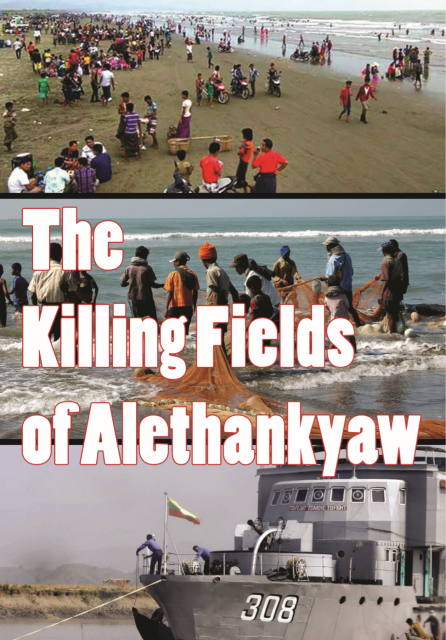The Killing Fields of Alethankyaw
22 November 2018

Summary
The centuries-old fishing community of Alethankyaw in southern Maungdaw is one of hundreds of Rohingya villages attacked and razed by Burmese government security forces during their brutal “clearance operations” that began in August 2017 and which drove over 720,000 refugees into Bangladesh.
The government maintains that the operations were in response to coordinated “terrorist” attacks on August 25 on thirty police posts, including in Alethankyaw, and that villagers burned their own houses and fled. But this report, based on in-depth interviews with thirty refugees from Alethankyaw, including fishermen, farmers, shopkeepers, housewives and teachers, tells a very different story: the nine-day assault by the Burma Army on their village was carefully pre-planned and implemented, and the 1,000-strong “terrorist” attack on Alethankyaw as described by the government did not and could not have happened.
Security infrastructure for the August 2017 operations was set in place well in advance. After the state-incited communal violence of 2012, the Burma Army had significantly expanded into southern Maungdaw to fortify the Naf estuary frontier—the so-called “western gateway” for extremist attacks. New military bases were built along the foot of the Mayu mountains. These were linked by a new restricted road to existing Border Guard Police (BGP) camps and Buddhist resettlement villages, which together strategically cordoned off the coastal plain from the mountainous hinterland.
A new military camp was also built on the beach next to Alethankyaw.
The security net tightened further after the initial clearance operations of October 2016, with military and police forces ramping up raids on Rohingya villages, and enforcing new restrictions, including grounding all Rohingya fishing boats, which paralyzed the fishing trade and cut off the main income source for the community.
By early August, there was thus a large locally based military force already in place to launch the 2017 clearance operations together with the combat divisions flown in from central Burma that month.
Villagers in Alethankyaw saw clear warning signs of the impending assault. Hundreds of troops were deployed into the village days beforehand, reinforcing the regional BGP camp in the centre of the village, as well as the two BGP outposts and army camp close to the beach. Two navy ships were moored off the shore. The army evacuated Rakhine inhabitants of the village by truck during the evening of August 24. Late that night, the Rakhine village administration officer phoned to Rohingya section leaders telling them that the army was going to shoot, and they should be ready to run.
Despite the overwhelming presence of security personnel, who were on heightened alert, the government claims that early on August 25, a thousand “extremist terrorists” swarmed up from the wide, flat beach and attacked an Alethankyaw police post. No interviewees saw any evidence of this large scale insurrection. They say it was logistically impossible for Rohingya to have organized such an attack, and it was the security forces who opened fire on the village without any external provocation.
At least fifty men, women and children were killed early that morning, mainly in the central sections of the village. At dawn, terrified villagers began evacuating en masse towards the Naf River to cross over to Bangladesh.
Over the next nine days, hundreds more troops were trucked in from the Kanhpu army base nearby. They patrolled around the central sections of the village, looting the market, seizing women, and shooting at civilians. Burma Army snipers positioned on the tops of the MPT and Telenor telecommunication towers were able to target a wide range around the village. Well over a hundred villagers were killed as they fled or tried to hide near their homes. Scores of bodies were dragged by troops and thrown into wells, as well as dumped under the Telenor tower, and into a pond near the beach.
By August 29, the centre of the village had been emptied, and the army began targeting the outer village areas. Troops marched on the Byuhakon section along the beach, where they tortured, killed and raped civilians, causing the remaining inhabitants to flee. That day, they began torching houses, and by early September, most of the village was in ashes, deserted by its over 11,000 Rohingya inhabitants.
Download full report HERE.
Announcements
28 February 2025
Asian NGO Network on National Human Rights Institutions , CSO Working Group on Independent National Human Rights Institution (Burma/Myanmar)
Open letter: Removal of the membership of the dis-accredited Myanmar National Human Rights Commission from the Southeast Asia National Human Rights Institution Forum

Progressive Voice is a participatory rights-based policy research and advocacy organization rooted in civil society, that maintains strong networks and relationships with grassroots organizations and community-based organizations throughout Myanmar. It acts as a bridge to the international community and international policymakers by amplifying voices from the ground, and advocating for a rights-based policy narrative.